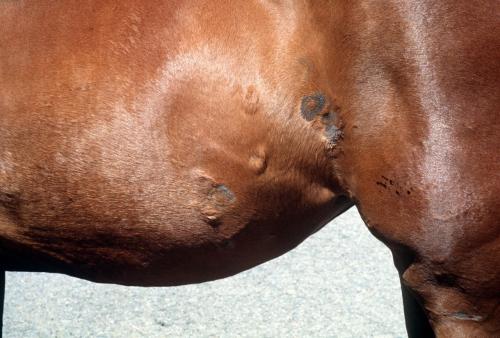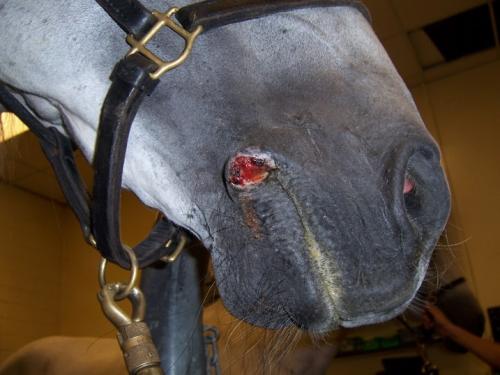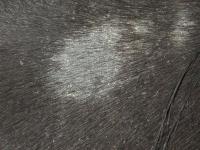Looks Can Be Deceiving
Ringworm and Its Look-alikes

On the surface, the term “ringworm” sounds straightforward. Although it can appear as a ring-like mark on the skin, it has nothing to do with worms. Ringworm is actually a fungus. To add to the deception, several conditions look like ringworm, but are something else entirely.
Summer Sores
Unlike ringworm, summer sores are actually caused by worms (scientific term: nematode). Habronemiasis, now called habronematidosis, is a disease attributed to any of the three species of Habronema worms that parasitize the horse: H. muscae, H. microstoma, and H. megastoma. Adult worms live in the stomach where they typically cause little reaction. Females lay eggs and the larvae are passed in the feces where they are ingested by the maggots of either the housefly or the stable fly, which serve as intermediate hosts. The normal life cycle is complete when flies deposit the infective larvae around the horse’s lips, where they are subsequently swallowed and the larvae develop into adults in the stomach.
Summer sores develop when the larvae are deposited in previously damaged skin or mucous membranes such as the lips, nostrils or genitalia where they cannot complete the life cycle and instead cause a local inflammatory reaction. The lesions themselves consist of areas of ulceration that usually contain small, gritty, yellow nodules (‘sulfur granules’).
The disease is seasonal, first appearing in the spring and in most cases spontaneously regressing in the winter months. Effective treatment involves a veterinarian cleaning the wound (debriding), often along with administration of ivermectin, corticosteroids, and topical treatments. The wound should be covered, if possible, and it is important to follow stringent fly management practices. Once the disease develops in a horse, it will usually recur every summer. A genetic susceptibility has been proposed in some horses, especially those affected annually, but further research is needed. Adhering to strict fly preventative measures can minimize recurrence, but it is difficult to completely prevent recurrence of summer sores.

Ringworm - Not a Worm
The medical term for ringworm, dermatophyte, may restore some faith as it does mean a fungus that infects the skin. Once an infection (dermatophytosis) is established, the offending fungus announces its presence, usually in the form of an itchy, circular pattern of hair loss (the ‘ring’), sometimes accompanied by redness or a rash. In horses, it commonly occurs on the girth and saddle areas and can spread to other parts of the body.
The skin reactions are easy to see, but the multiple species of dermatophytes that can infect horses are less than forthcoming about their everyday presence, hiding out of sight in the soil, or stowing away on fomites such as shared grooming equipment and tack. The fungus can be present on horses for a few weeks before clinical signs appear, and can spread from one horse to another by direct contact. These sneaky tactics mean that ringworm can also infect people or other animals, spreading through otherwise seemingly innocuous routes.
Diagnosing ringworm involves taking a hair sample for a fungal culture in the laboratory. It is important to confirm the diagnosis, as other conditions can mimic ringworm in appearance, and the most effective treatments can be very different.
Ringworm Look-alikes

Although ringworm is a common equine skin condition, it is not the only possible cause of hair loss and rashes. Ringworm look-alikes include bacterial (‘staph’) skin infection, occult sarcoid (a type of skin cancer), and alopecia areata, a rare autoimmune skin disease where the body’s immune system mistakenly attacks the hair bulb. Rain scald (dermatophilosis) may also resemble ringworm.
Ignore It and It Will Go Away?
In some cases, ringworm resolves on its own without treatment, but it can take a month or more. Therefore, it is important to treat horses as soon as possible to limit their discomfort and avoid spreading the fungus to other animals and people.
Treatment may consist of antifungal shampoos, dips, or topical therapies. Oral treatments such as griseofulvin and terbinafine are also available, but potential unwanted side effects, such as liver damage, evidenced by elevated liver enzymes, and birth defects, should be taken into account. It is important to follow veterinary and product instructions to get the maximum effect. Treatment also extends beyond the horse. Tack, blankets, grooming equipment, and other potentially contaminated surfaces should be disinfected to limit the spread of disease. If a known soil-borne fungal species is identified through laboratory culture, the ground and/or stall floor should be treated with bleach to try to eliminate the organism.
Whereas bacteria usually grow quickly in culture, fungi grow in the laboratory over a period of weeks. It is not uncommon for clinical signs to resolve before the results of the culture are known. However, the results may still be beneficial for cases that are difficult to treat, or to provide information on appropriate treatments for other affected animals on the premises and limit the potential spread to humans.
